IEC TS 63105 pdf – Lighting systems and related equipment – Vocabulary

IEC TS 63105 pdf – Lighting systems and related equipment – Vocabulary
isPS4ment estabnsnBs ner rolde of nt om n v n·
2Normative references
There are no normative references in this document.
Terms and definitions
ISO and lEC maintain terminological databases for use in standardization at the followingaddresses:
.IEC Electropedia: available at http://www.electropedia.orgl
· Iso Online browsing platform: available at http://www.iso.orglobp3.1 Lighting
3.1.1
lighting
illumination
application of light to a scene, objects, or their surroundings
[SOURCE: IEC 60050-845:2020,845-29-001, modified – The note has been deleted.]
3.1.2
adaptive lighting
lighting responding to circumstances or according to predefined conditions, while maintainingthe lighting quality within the specified requirements for these circumstances or conditions
Note 1 to entry: The requirements can focus on different aspects such as energy efficiency,dynamic user needs,visual tasks or ambience.
Nolte 2 to entry: The terms “smart lighting” and “intelligent lighting”are sometimes used with a similar meaning.[SOURCE: IEC 60050-845:2020,845-29-027]
3.1.3
integrative lighting
lighting integrating both visual and non-visualeffects,and producing physiological and/orpsychological benefits upon humans
Note 1 to entry: The term “integrative lighting”applies only to humans.
Note 2 to entry: Lighting primarily for therapeutic purposes (light therapy) is not included.Note 3 to entry: The term “human-centric lighting”is used with a similar meaning.
[SoURCE: IEC 60050-845:2020,845-29-028]
3.2 Lighting systems3.2.1
system
set of interrelated items that collectively fulfil a requirement
Note 1 to entry: A system is considered to have a defined real or abstract boundamy.
Note 2 to erniry. Extemnalresouroes (from oulside the system boundary) can be required for the systems to operate.Note 3 to entry:A system struclure can be hierarchical, e. g. systerm,subsysterm,component,etc.,
Note 4 to entry: Conditions of use and maintenance can be expressed or limplied within the requlrement.
[SOURCE: IEC 60050-192:2015,192-01-03,modified -The verbal forms “may”and “should””in the notes have been replaced with ” can”.The domain of application has been removed.J
3.2.2
lighting system
system (IEV192-01-o3) designed to provide lighting (IEV 845-29-001)
Note 1 to entry:A lighting system can ba dadicated to
a) the suppart of one or mare specilied visul tasks under specilied condions considering other requirements suchas human comfort,salety, the appearance of the surrounding ervironment and energy consumption:;
the support of other than human tasks
Note 2 to enty. A lighting system can include a set of light sourOes,other physical components,communicationprotocols,user interfaces,sofware and networks to provide centrall control and monitoring functions.
Note 3 to entry: The light source(s) and the related equipment can be integrated in a single item,e.g.an LEDmodule,a lamp or a luninaire.
Ncke 4 to entry:Alighting system can be networked to provide central or remole control and monitoring funclions,Note 5 to enty.:Alighting system can be connected to or integrated with other systems or devicas.
[SOURCE: IEC 60050-845:2020,845-27-010]
3.2.3
adaptive lighting system
lighting system designed for adaptive lighting
3.2.4
integrative lighting system
lighting system designed for integrative lighting
3.2.5
lighting system network
interconnection (wired or wireless) between lighting system devices used for internal or externalcommunication
Ncte 1 to entry: A lighting system network can carry digital data as well as analogue signals.3.2.6
energy performance
[SoURCE: IEC 60050-845;2020,845-27-121]
3.2.7
lighting quality
degree of excellence to which the totality of lighting characteristics fulfils user needs andexpectations or other applicable requirements
Note 1 to entry: The degree of excellence is not a quantitative measure but depends on the application area andcovers individualend-user well-being,safety and public security,architecture and lit environment.
[SOURCE: IEC 60050-845:2020,845-29-029]
3.2.8
networked device
3.2.9
sensor
electric sensor
device which,when excited by a physical phenomenon,produces an electric signalcharacterizing the physical phenomenon
[SOURCE: IEC 60050-151:2001,151-13-48]
3.2.10
compatibility
ability of a system or system components to have coexistence,interoperability, and/orinterchangeability with other systems or systems components, depending on the context
Note 1 to entry: Because the tems “compatible”and “compatibility”are ambiguous, their use is not recommendedwhen other tems are more specific. See defitions of coexistence(3.2.11),interoperability(3.2.12),andinterchangeability(3.2.13)to determine which are most appropriate.
3.2.11
coexistence
ability of systems or system components to operate together without having harmful orundesirable effects on each other
3.2.12
interoperability
ability of systems or systems components to transmit,receive,interpret,and/or react to dataand/or power and function in a specified manner
3.2.13
interchangeability
ability of a system component to replace the form and fit of another system component andperform in an equivalent way









